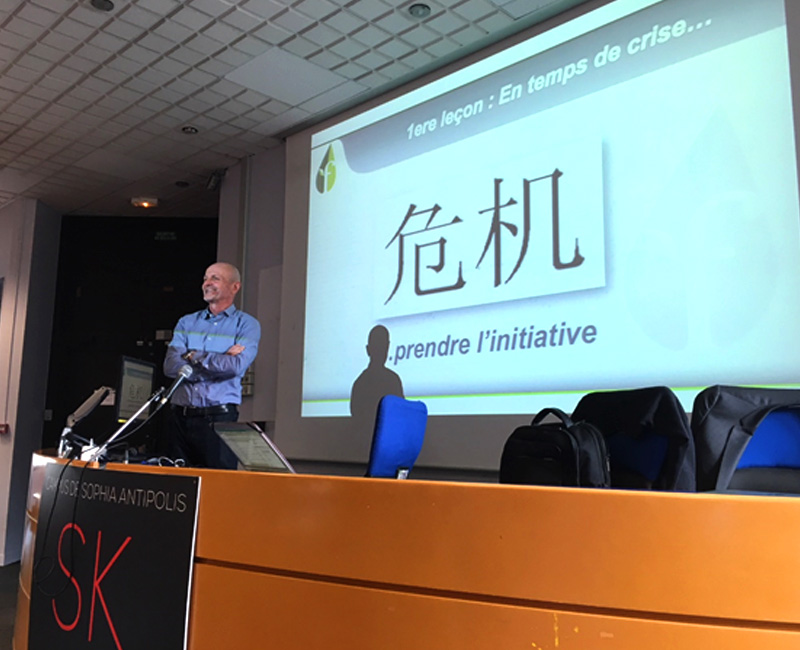In the wake of VivaTech’s success, which has become an essential event for innovation-driven and innovative companies, and in view of the ever-growing flow of entrepreneurial projects, we can wonder about the small proportion of innovations that ultimately allow businesses or entrepreneurs to accelerate their growth or simply survive. Is the rather recent dominant thought to anchor innovation in companies’ culture unfounded? Certainly not, given the increasingly shortened industry and product life cycles. The reason must be elsewhere.
When a company innovates, it embarks on a process that affects every part of the organization and all aspects of operations. This renders it complex for the company to durably capture the positive outcomes of the efforts it makes, as the competences and the organizational structure required to explore and achieve innovation are rather different from those that allow the long-term exploitation of the innovation’s benefits. Here, the notion of alignment or fit between the company’s strategic choices (competitive positioning, growth options, and modes) and its associated innovation behavior is essential.
The conclusions of many field-based studies conducted side-by-side with samples of companies of all types converge: When entrepreneurs choose and implement their strategy, they should consider the appropriate combination of nature (incremental, radical, sustaining, disruptive), source (market-based, technology-based) and activities (product, process, marketing, organizational, business model) of innovation that corresponds to their strategic posture, to the characteristics of their target markets and their available capabilities. In other words, companies cannot afford to adopt innovation behaviors that are not in line with their strategic objectives.
 In fact, it all makes sense, doesn’t it? However, I am always surprised by the “one size fits all” or “along the way” approach chosen by (or recommended to?) entrepreneurs and the related rate of companies’ failures. This is linked to the fact that the perception of environmental uncertainty and complexity influences companies’ strategic choices, the allocation and development of resources, and consequently the management and organizing of innovation. If things are not aligned, it is bound to fail. Do not misunderstand me. In a fast-changing environment, this is not about rigidity. It is about dynamic consistency.
In fact, it all makes sense, doesn’t it? However, I am always surprised by the “one size fits all” or “along the way” approach chosen by (or recommended to?) entrepreneurs and the related rate of companies’ failures. This is linked to the fact that the perception of environmental uncertainty and complexity influences companies’ strategic choices, the allocation and development of resources, and consequently the management and organizing of innovation. If things are not aligned, it is bound to fail. Do not misunderstand me. In a fast-changing environment, this is not about rigidity. It is about dynamic consistency.
Implementing Innovation
Truly, one size does not fit all, and the strategic management of innovation (achieving objectives and capturing durable value, thanks to innovation) rests on a dual assumption: (1) Certain specific fits between strategic positioning and innovation behavior are preferable in terms of efficiency and performance. (2) The relationship between strategy and innovation is influenced by the company’s external (market complexity and uncertainty) and internal (competences and resources) environment. Long story short, companies must make trade-offs between emphasizing exploration or exploitation along the process of innovation management. This involves different successive phases to implement the innovation process, launch the innovation itself and manage its exploitation. The phases can be summarized as follows:
- Continuous surveillance of the company’s external and internal environment to seek opportunities (latent or expressed needs, results of research, changes in regulations, behavior of competitors…) that could be potential sources of innovation.
- Selecting the opportunities where the company will mobilize its resources. At this stage, it is important to look at the chosen opportunities in relation to the company’s strategic posture and capabilities to know how to use them to develop a competitive advantage.
- Allocating the resources (either available resources mobilized internally or external resources) for exploring the retained opportunities.
- Initiating the innovation process — from the first idea to launching a new product and/or service, a new internal process, a new marketing method or a new organizational method to generate competitive advantage.
- Exploiting all efforts to the greatest extent by optimizing the capture of revenues from the innovation.
- Then, when the competitive advantage weakens, reconfiguring the company to follow up the exploitation of the innovation and identify new opportunities to explore.
Strategic Innovation Portfolio
In this context of exploration-exploitation trade-offs, entrepreneurs should design an innovation portfolio[i] that reflects their strategic choices regarding where to innovate (in existing, adjacent, or new markets) as well as how to innovate (with existing, adapted, or completely new products and assets). These choices will lead to a portfolio of respectively “core” innovations, “adjacent” innovations and “transformational” innovations. Sticking to the assumption that one size does not fit all, companies should adjust the innovation portfolio according to their entrepreneurial orientation[ii]. Defenders (who choose to develop in stable product/market domains) should choose an 80/20/0 mix of innovations. Prospectors (who permanently track market or product opportunities) should go for a 45/40/15 portfolio, whereas analyzers (who follow a hybrid strategy) should favor a 70/20/10 mix.
These are only generic indications that must be taken with caution with regards to companies’ markets and stage of development. But field practice, as well as academic research, have shown that it usually pays off to stick to models.
To know more about how to combine strategy and innovation: Strategic Consulting: Tools and Methods for Successful Strategy Missions, PALGRAVE, Chereau P., Meschi P.X., (2017).
[i] Nagji Bansi and Tuff Geof, 2012
[ii] Miles Raymond and Snow Charles, 2003
Written by: Dr. Philippe Chereau



